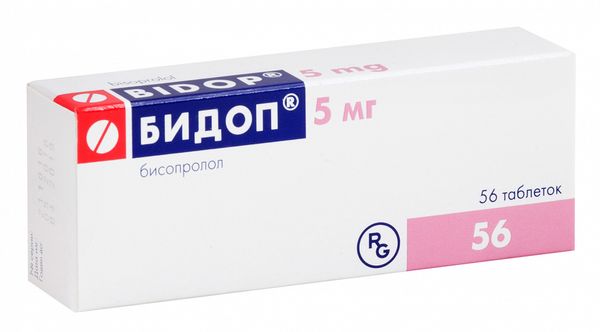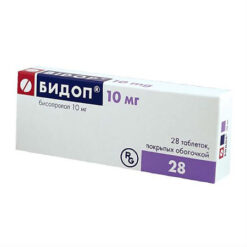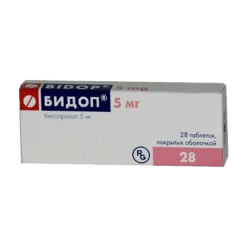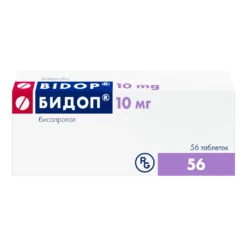No products in the cart.
Bidop, tablets 5 mg 56 pcs.
€8.44 €7.38
Description
A selective beta1-adrenoblocker without intrinsic sympathomimetic activity, has no membrane stabilizing effect. Reduces plasma renin activity, reduces myocardial oxygen demand, reduces HR (at rest and under load).
It has hypotensive, antiarrhythmic and antianginal action. In low doses it blocks β1-adrenoceptors of heart, decreases catecholamine-stimulated cAMP formation from ATP, decreases intracellular calcium ion current, produces negative chrono-, dromo-, batmo- and inotropic effects, inhibits conduction and excitability.
If the therapeutic dose is exceeded, it has beta2-adrenoblocking effect.
In the beginning of the drug administration, during the first 24 h, RPS increases (as a result of reciprocal increase of α-adrenoreceptor activity and elimination of β2-adrenoreceptor stimulation), after 1-3 days RPS returns to baseline, and with long-term treatment it decreases.
Hypotensive effect is associated with decreased minute blood volume, sympathetic stimulation of peripheral vessels, decreased activity of renin-angiotensin system (of greater importance for patients with initial renin hypersecretion), restoration of sensitivity in response to BP reduction and influence on CNS. For arterial hypertension the effect develops in 2-5 days, stable effect – in 1-2 months.
The antianginal effect is caused by decrease of myocardial oxygen demand as a result of HR shortening and decrease of contractility, prolongation of diastole, improvement of myocardial perfusion. By increasing left ventricular end-diastolic pressure and increasing ventricular muscle fiber stretch may increase oxygen demand, especially in patients with chronic heart failure.
The antiarrhythmic effect is caused by the removal of arrhythmogenic factors (tachycardia, increased activity of the sympathetic nervous system, increased content of CAMF, arterial hypertension), decrease of spontaneous excitation rate of sinus and ectopic pacemakers and slowing of AV conduction (mainly in antegrade and, to a lesser extent, in retrograde direction through the AV node) and through additional pathways.
When used in medium therapeutic doses, unlike non-selective beta-adrenoblockers, it has less pronounced effect on organs containing β2-adrenoreceptors (pancreas, skeletal muscles, smooth muscles of peripheral arteries, bronchi and uterus) and carbohydrate metabolism, does not cause retention of sodium ions in the body; intensity of atherogenic action does not differ from that of propranolol.
Indications
Indications
Arterial hypertension; IHD: prevention of attacks of stable angina.
Pharmacological effect
Pharmacological effect
A selective beta1-blocker without internal sympathomimetic activity and does not have a membrane-stabilizing effect. Reduces plasma renin activity, reduces myocardial oxygen demand, and reduces heart rate (at rest and during exercise).
It has hypotensive, antiarrhythmic and antianginal effects. By blocking β1-adrenergic receptors of the heart in low doses, it reduces the catecholamine-stimulated formation of cAMP from ATP, reduces the intracellular current of calcium ions, has a negative chrono-, dromo-, bathmo- and inotropic effect, inhibits conductivity and excitability.
When the therapeutic dose is exceeded, it has a beta2-adrenergic blocking effect.
At the beginning of the use of the drug, in the first 24 hours, OPSS increases (as a result of a reciprocal increase in the activity of α-adrenergic receptors and elimination of stimulation of β2-adrenergic receptors); after 1-3 days, OPSS returns to the original level, and with long-term treatment it decreases.
The hypotensive effect is associated with a decrease in minute blood volume, sympathetic stimulation of peripheral vessels, a decrease in the activity of the renin-angiotensin system (of greater importance for patients with initial hypersecretion of renin), restoration of sensitivity in response to a decrease in blood pressure and an effect on the central nervous system. In case of arterial hypertension, the effect develops after 2-5 days, stable effect – after 1-2 months.
The antianginal effect is due to a decrease in myocardial oxygen demand as a result of a decrease in heart rate and decreased contractility, prolongation of diastole, and improved myocardial perfusion. By increasing end-diastolic pressure in the left ventricle and increasing the stretch of ventricular muscle fibers, it can increase oxygen demand, especially in patients with chronic heart failure.
The antiarrhythmic effect is due to the elimination of arrhythmogenic factors (tachycardia, increased activity of the sympathetic nervous system, increased cAMP content, arterial hypertension), a decrease in the rate of spontaneous excitation of sinus and ectopic pacemakers and a slowdown of AV conduction (mainly in the antegrade and, to a lesser extent, in the retrograde directions through the AV node) and along additional pathways.
When used in average therapeutic doses, in contrast to non-selective beta-blockers, it has a less pronounced effect on organs containing β2-adrenergic receptors (pancreas, skeletal muscles, smooth muscles of peripheral arteries, bronchi and uterus) and on carbohydrate metabolism, does not cause retention of sodium ions in the body; the severity of the atherogenic effect does not differ from the effect of propranolol.
Special instructions
Special instructions
Monitoring of patients taking Bidop should include measurement of heart rate and blood pressure (at the beginning of treatment – daily, then once every 3-4 months), an ECG, determination of blood glucose in patients with diabetes (once every 4-5 months).
In elderly patients, it is recommended to monitor renal function (once every 4–5 months).
Active ingredient
Active ingredient
Bisoprolol
Composition
Composition
1 tablet contains bisoprolol hemifumarate 5 mg.
Excipients:
lactose monohydrate,
microcrystalline cellulose,
magnesium stearate, crospovidone,
pigment brand PB 27215 beige (lactose monohydrate 87%, iron oxide red and yellow 13%).
Pregnancy
Pregnancy
The use of the drug during pregnancy and lactation is possible only if the expected benefit to the mother outweighs the potential risk to the fetus and child.
There is no data on whether bisoprolol passes into breast milk. If it is necessary to use the drug during lactation, it is recommended to stop breastfeeding.
Contraindications
Contraindications
hypersensitivity to bisoprolol and other beta-blockers;
shock (including cardiogenic), collapse;
acute heart failure, pulmonary edema;
chronic heart failure in the stage of decompensation (including cardiogenic shock);
AV block II–III stage, sinoatrial block, sick sinus syndrome;
severe bradycardia;
Prinzmetal’s angina;
cardiomegaly (without signs of heart failure);
arterial hypotension (sBP
history of bronchial asthma and COPD;
simultaneous use of MAO inhibitors (with the exception of MAO-B inhibitors);
late stages of peripheral circulatory disorders;
Raynaud’s disease;
pheochromocytoma (without simultaneous use of alpha-blockers);
metabolic acidosis;
age under 18 years (efficacy and safety have not been established).
Side Effects
Side Effects
Side effects observed with the use of the drug Bidop are classified into categories depending on the frequency of their occurrence: very often (≥ 1/10); often (≥ 1/100, < 1/10); uncommon (≥ 1/1000, < 1/100); rare (≥ 1/10,000, < 1/1000); very rare (<1/10,000), including isolated reports.
From the central nervous system and peripheral nervous system: infrequently – increased fatigue, weakness, asthenia, dizziness, headache, sleep disorders, depression, anxiety, confusion or short-term memory loss; rarely – hallucinations, myasthenia gravis, nightmares, cramps (including in the calf muscles), paresthesia in the extremities (in patients with intermittent claudication and Raynaud’s syndrome), tremor.
From the senses: rarely – blurred vision, decreased secretion of tear fluid, dryness and soreness of the eyes; very rarely – conjunctivitis.
From the cardiovascular system: very often – sinus bradycardia, palpitations; often – a pronounced decrease in blood pressure, manifestation of vasospasm (increased peripheral circulatory disorders, coldness of the lower extremities, Raynaud’s syndrome); uncommon – orthostatic hypotension, myocardial conduction disturbances, AV block (up to the development of complete transverse block and cardiac arrest), arrhythmias, weakened myocardial contractility, development of chronic heart failure (swelling of the ankles, feet; shortness of breath), chest pain.
From the digestive system: often – dryness of the oral mucosa, nausea, vomiting, abdominal pain, constipation or diarrhea; rarely – liver dysfunction (dark urine, yellowness of the sclera or skin, cholestasis), changes in taste, hepatitis, increased activity of liver enzymes (AST, ALT), hyperbilirubinemia, hypertriglyceridemia.
From the respiratory system: infrequently – difficulty breathing when prescribed in high doses (loss of selectivity) and/or in predisposed patients – laryngo- and bronchospasm; rarely – nasal congestion.
From the endocrine system: hyperglycemia (in patients with non-insulin-dependent diabetes mellitus), hypoglycemia (in patients receiving insulin), hypothyroid state.
Allergic reactions: rarely – itching, rash, urticaria.
Dermatological reactions: rarely – increased sweating, skin hyperemia; very rarely – exanthema, psoriasis-like skin reactions, exacerbation of psoriasis symptoms, alopecia.
From the hematopoietic system: in some cases – thrombocytopenia (unusual bleeding and hemorrhage), agranulocytosis, leukopenia.
Other: infrequently – arthralgia; rarely – back pain, weakened libido, decreased potency, withdrawal syndrome (increased angina attacks, increased blood pressure).
Interaction
Interaction
Allergens used for immunotherapy or allergen extracts for skin testing increase the risk of severe systemic allergic reactions or anaphylaxis in patients receiving bisoprolol.
Iodine-containing radiopaque drugs for intravenous administration increase the risk of anaphylactic reactions. Phenytoin, when administered intravenously, and drugs for inhalation general anesthesia (hydrocarbon derivatives) increase the severity of the cardiodepressive effect and the likelihood of a decrease in blood pressure.
Changes the effectiveness of insulin and oral hypoglycemic drugs, masks the symptoms of developing hypoglycemia (tachycardia, increased blood pressure).
Reduces the clearance of lidocaine and xanthines (except theophylline) and increases their concentration in plasma, especially in patients with initially increased clearance of theophylline under the influence of smoking. The hypotensive effect is weakened by NSAIDs (retention of sodium ions and blockade of prostaglandin synthesis by the kidneys), corticosteroids and estrogens (retention of sodium ions).
Cardiac glycosides, methyldopa, reserpine and guanfacine, slow calcium channel blockers (verapamil, diltiazem), amiodarone and other antiarrhythmic drugs increase the risk of developing or worsening bradycardia, AV block, cardiac arrest and heart failure.
Overdose
Overdose
Symptoms: arrhythmia, ventricular extrasystole, severe bradycardia, AV block, marked decrease in blood pressure, chronic heart failure, cyanosis of fingernails or palms, difficulty breathing, bronchospasm, dizziness, fainting, convulsions, hypoglycemia.
Treatment: gastric lavage and administration of adsorbent drugs; symptomatic therapy: for developed AV blockade – 1-2 mg of atropine, epinephrine intravenously or placement of a temporary pacemaker; for ventricular extrasystole – lidocaine (class I A drugs are not used); when blood pressure decreases, the patient should be in the Trendelenburg position; if there are no signs of pulmonary edema, – intravenous plasma-substituting solutions, if ineffective – administration of epinephrine, dopamine, dobutamine (to maintain chronotropic and inotropic effects and eliminate a pronounced decrease in blood pressure); for heart failure – cardiac glycosides, diuretics, glucagon; for convulsions – intravenous diazepam; for bronchospasm – beta2-adrenergic stimulants by inhalation.
Storage conditions
Storage conditions
Store in a dry place, protected from light, out of reach of children, at a temperature not exceeding 20 °C.
Shelf life
Shelf life
3 years.
Manufacturer
Manufacturer
Gedeon Richter-RUS, Russia
Additional information
| Shelf life | 3 years. |
|---|---|
| Conditions of storage | Store in a dry place protected from light, out of reach of children, at a temperature not exceeding 20 ° C. |
| Manufacturer | Gedeon Richter Rus, Russia |
| Medication form | pills |
| Brand | Gedeon Richter Rus |
Other forms…
Related products
Buy Bidop, tablets 5 mg 56 pcs. with delivery to USA, UK, Europe and over 120 other countries.


















